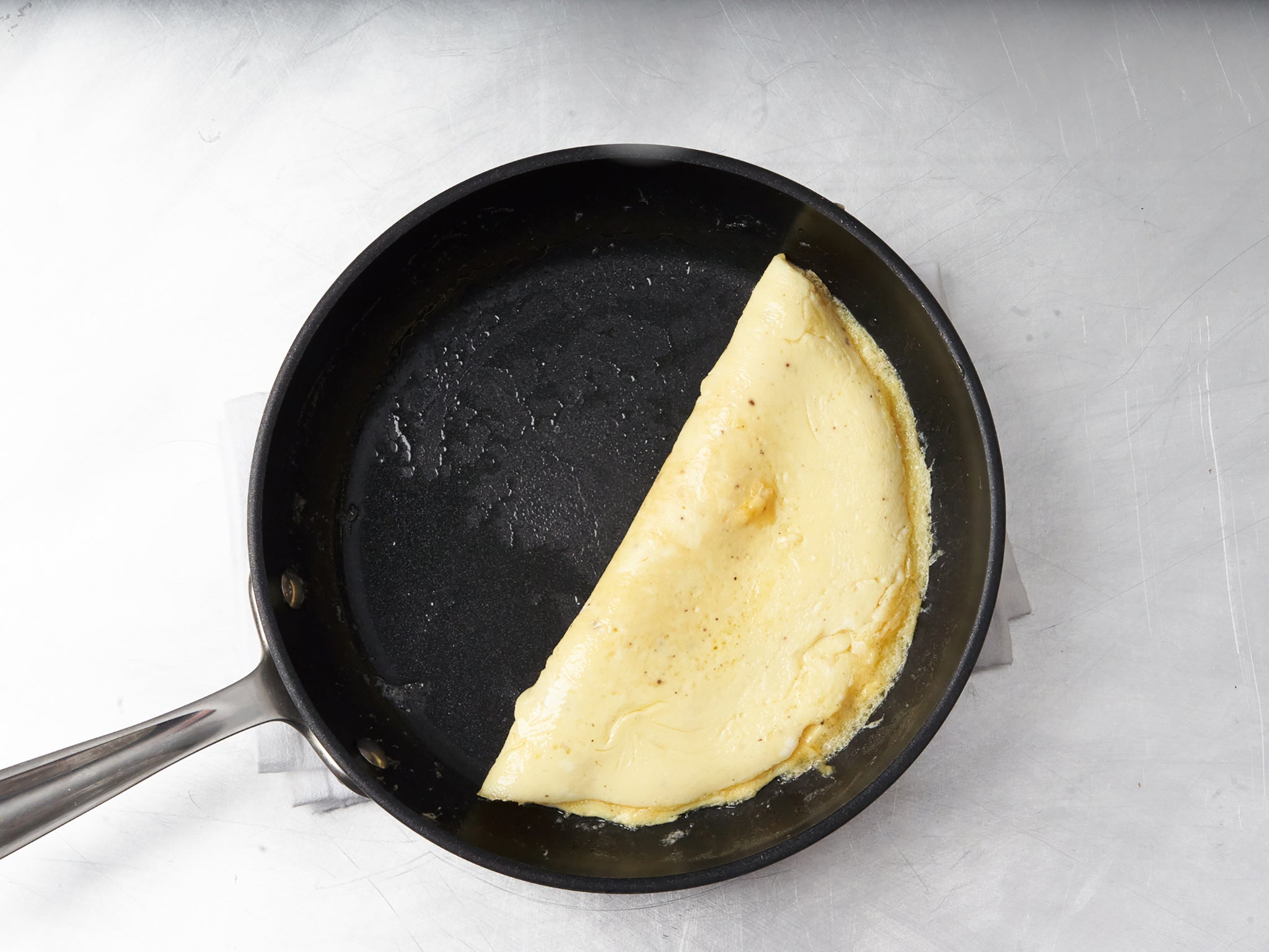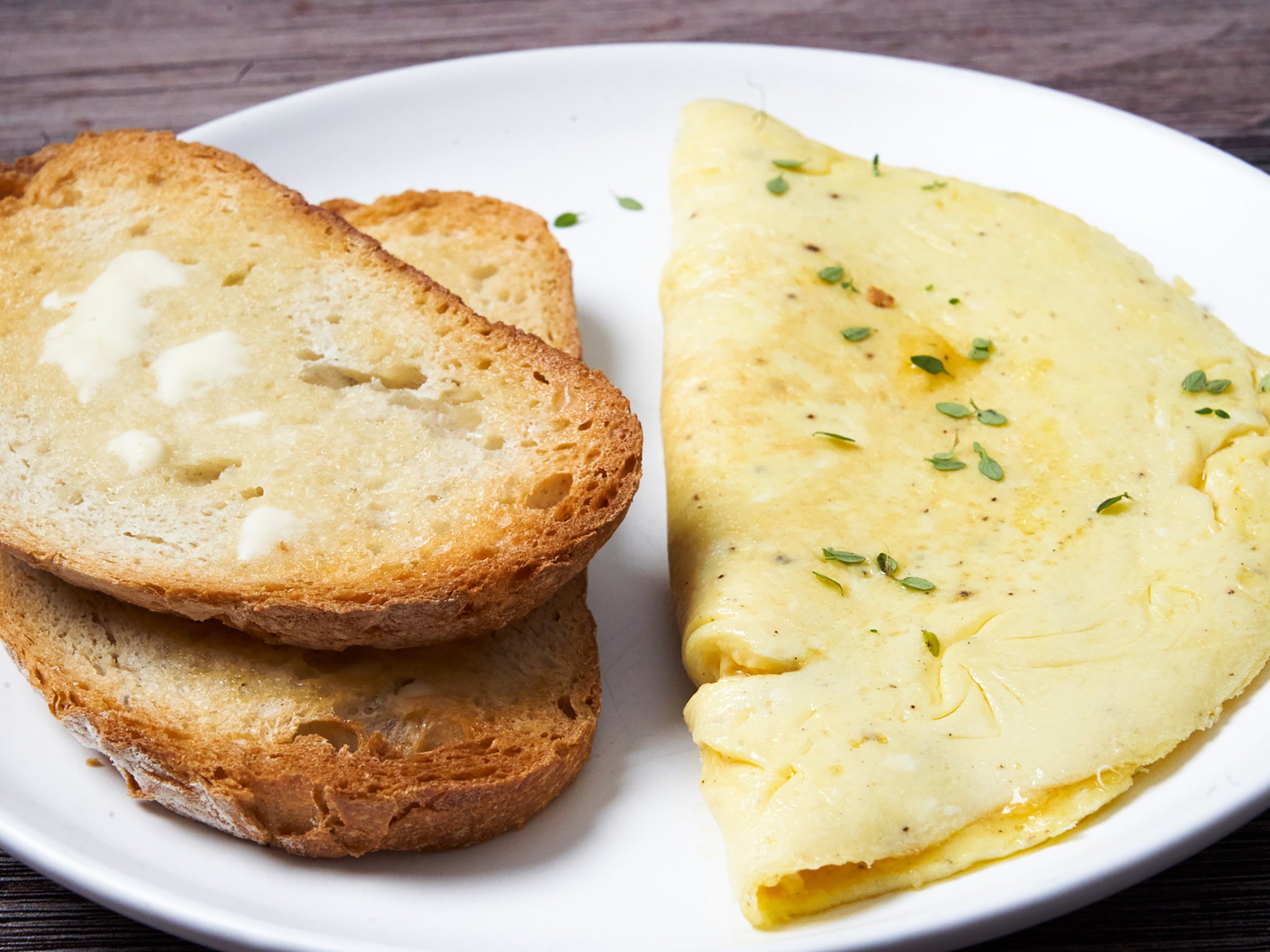How to make the perfect omelette
Cooking an omelette at home needn’t be shrouded in mystery, says Becky Krystal. With a little help from some cooking legends, here’s the keys to success

Your support helps us to tell the story
From reproductive rights to climate change to Big Tech, The Independent is on the ground when the story is developing. Whether it's investigating the financials of Elon Musk's pro-Trump PAC or producing our latest documentary, 'The A Word', which shines a light on the American women fighting for reproductive rights, we know how important it is to parse out the facts from the messaging.
At such a critical moment in US history, we need reporters on the ground. Your donation allows us to keep sending journalists to speak to both sides of the story.
The Independent is trusted by Americans across the entire political spectrum. And unlike many other quality news outlets, we choose not to lock Americans out of our reporting and analysis with paywalls. We believe quality journalism should be available to everyone, paid for by those who can afford it.
Your support makes all the difference.At hotel breakfasts, fancy brunches or even the university dining hall, the omelette station always felt like the height of luxury to me. Omelettes hold a revered, almost mythical position in popular and culinary culture as well, whether it’s the hypnotic comfort of famed French chef and cookbook author Jacques Pépin demonstrating his recipe or watching Helen Mirren’s character discover the bliss of a masala omelette made by the aspiring chef played by Manish Dayal in The Hundred-Foot Journey.
But cooking a great omelette at home needn’t be shrouded in mystery. If you already feel confident about your scrambled eggs, you’re most of the way there. In CookWise, Shirley O Corriher explains: “Basically, omelettes are glorified scrambled eggs. They start out the same way, and then, when the eggs are partially set but still juicy, they are folded over.”
For me, that advice is exemplified by this classic folded omelette, a mashup of recipes from chef and cookbook author Michel Roux and cookbook author J Kenji López-Alt, along with some of my personal tweaks. Think of it as a cross between a French omelette and a diner-style omelette. It has the smooth and custardy texture of the French version, with the folded appearance and filling versatility of what you might get at a casual restaurant. To me, it’s the best of both worlds.
Here are some of the keys to its success, which can help with your omelettes whether you make this specific recipe or not.
Picking the right pan
There are two parts to this. Eggs are prone to sticking because in their liquid form they can flow into any microscopic surface imperfections, Corriher says. For this reason, I turn to my nonstick frying pan. If you have a well-seasoned cast-iron pan you’re confident the eggs won’t stick to, by all means use it.
The other half of the equation is choosing the right size pan for the job. I’m really loving my new 20cm pan for individual or two-serving omelettes. It keeps the eggs from spreading too thin and overcooking. It’s also very easy to manoeuvre. If you’re looking for bigger omelettes to share, consider using a 25cm for 4 or 5 eggs and moving up to 30cm for 6 or more eggs.
Salting
López-Alt is the one who sold me on salting eggs a little bit in advance of when you cook them. This gives the salt time to dissolve evenly so that it can act as the most efficient buffer between the egg proteins and prevent them from binding too tightly. When that happens, moisture is squeezed out and you get tough, rubbery eggs. If you forget to salt in advance, adding it right before the eggs go into the pan is OK. But if you think to add the salt at the same time you start preheating the pan, you’ll be golden. Speaking of preheating…
Be patient, then work quickly
A sufficiently preheated pan will help guard against sticking, so that the eggs start cooking as soon as they hit the pan. As Cook’s Illustrated notes, preheating your pan slowly leads to a more even heat across the whole pan – and gives you a larger window for adding your eggs without overcooking them. While the magazine recommends low heat, I prefer medium for a slightly quicker but no less even result. When using medium-high heat, I found more colour variation in the omelette than I wanted, as well as a tendency for overcooking. If you’re a confident cook who likes a bit more puff and colour to the omelette, you can use medium-high so long as you take the higher heat into account with your timing.
Here’s where the working quickly part comes in. Once your pan has been preheated, and you pour in the egg, it’s time to embrace the speed. Quickly stir the eggs to further distribute the heat and get all of them cooking. Once curds start to form, stop. Rapidly work your way around the pan, lifting the edge of the set eggs and tilting the pan so that the liquid runs into the gaps on the sides. This method gives you a smooth, pretty exterior. The whole process should take no more than a minute and a half.
Mind the fillings
Because the omelette itself sets so quickly, López-Alt says, any fillings that need to be softened should be completely or mostly cooked in advance, as they won’t cook through while atop the eggs. You can do this in the pan while your salted eggs rest in a bowl or in a separate pan. Mixing the warm ingredients with the cheese will help jump-start melting, too. Then scatter your filling over half the eggs while they’re still in the pan just before you remove it from the heat.
Let the eggs finish off heat
After you’re done with the tilting step, let the pan stay on the heat until the eggs are almost completely set. They will still look wet but should not be runny. This is the point where it’s easy to let the eggs overcook, which is why I like López-Alt’s suggestion to remove the pan from the heat and then cover the pan to let the eggs finish in the residual heat. Simply fold in half (or thirds, if that’s your thing) and serve. The result: a creamy, custardy omelette.
You may need to practice and tweak, but it won’t be long before you have your own omelette station at home.
Classic omelettete

Total time: 15 minutes
Serves: 1 to 2 servings
Omelettes are simple to make and easy to mess up, so we’re offering a recipe with a few smart tips to ensure success. Salting the eggs a little before cooking and then letting them finish setting off the heat helps ensure a tender result without overcooking.
For tips on how to turn this into a filled omelette see the variation, below.
Ingredients:
3 large eggs
Fine salt
Freshly ground black pepper
1 tbsp unsalted butter
Fresh herbs for garnish, such as thyme leaves, minced chives or chopped parsley (optional)
Method:
Break the eggs into a small bowl, season lightly with salt and pepper and, using a fork, lightly whisk to combine. Let them rest for at least 10 minutes (15 is even better) while you heat the pan and prepare any possible fillings (see variatian below). Salting in advance helps keep the eggs tender during cooking.
Heat an 20cm nonstick frying pan over medium heat. Be sure you give it enough time to ensure the eggs start cooking right away. A few drops of water flicked on the surface should skitter and evaporate immediately. Add the butter to melt, swirling it to coat the bottom and sides of the pan.
Pour the eggs into the pan and let the mixture set for 10 to 20 seconds, then use a spatula to start agitating the mixture, stirring until some curds begin to form. Lift the edges of the coagulated egg and tilt the pan to let the uncooked egg fill in the gaps. Repeat the process as you work your way around the entire pan. This part should take no more than 60 to 90 seconds. When the omelette has set on the bottom but still looks slightly wet but not runny on top, pull the pan off the heat and cover it with a tightfitting lid or plate. Let rest until the eggs have reached your desired consistency, 1 to 2 minutes.
Use a spatula to fold the omelette in half and transfer to a plate. Sprinkle the herbs on top, if using, and serve hot.
Variation: You can use this recipe to make your choice of filled omelette. Vegetables will not cook through sufficiently in the omelette, so you’ll want to saute them first in butter or oil, over medium to medium-high heat. Transfer to a bowl, where you can mix with grated or crumbled cheese, if using. When the eggs are almost set, sprinkle your filling on half the omelette before removing from the heat and covering to rest. Then fold in half and serve.
Nutrition information per serving, based on 2 | Calories: 158; total fat: 13g; saturated fat: 6g; cholesterol: 294mg; sodium: 204mg; carbohydrates: 1g; dietary fibre: 0g; sugar: 0g; protein: 9g.
This analysis is an estimate based on available ingredients and this preparation. It should not substitute for a dietitian’s or nutritionist’s advice.
Based on a recipe adapted by Andreas Viestad from ‘Eggs’, by Michel Roux (John Wiley & Sons, 2006), as well as a recipe from ‘The Food Lab’, by J Kenji López-Alt (WW Norton, 2015).
© The Washington Post

Join our commenting forum
Join thought-provoking conversations, follow other Independent readers and see their replies
Comments